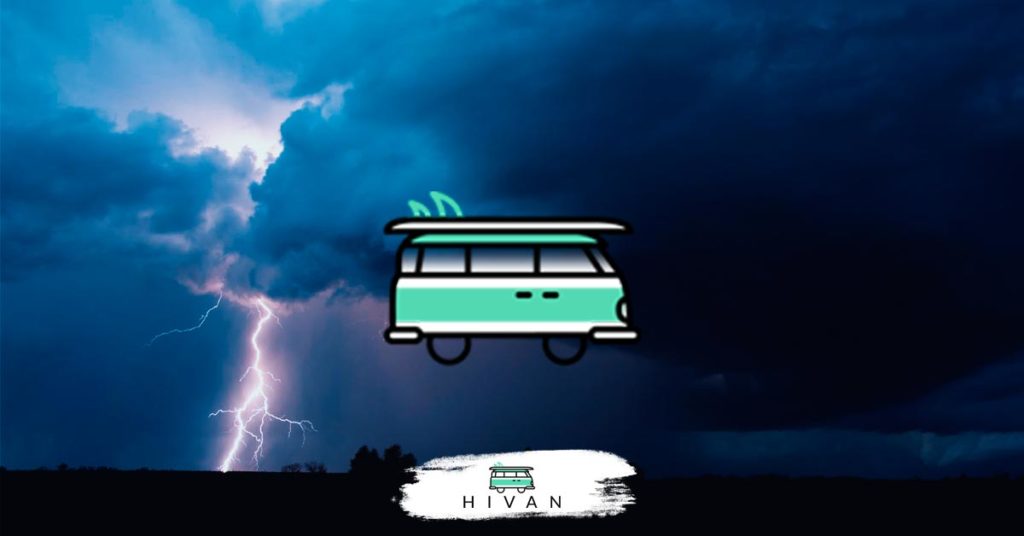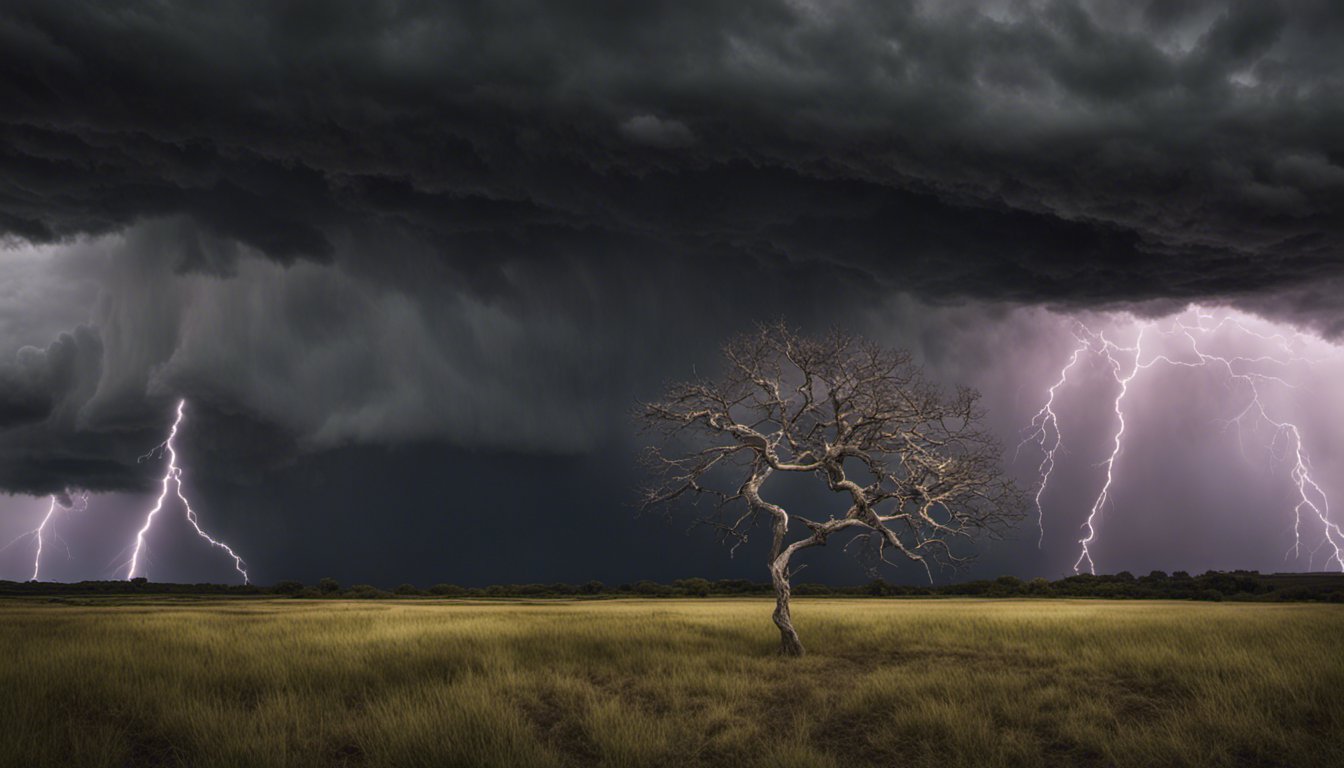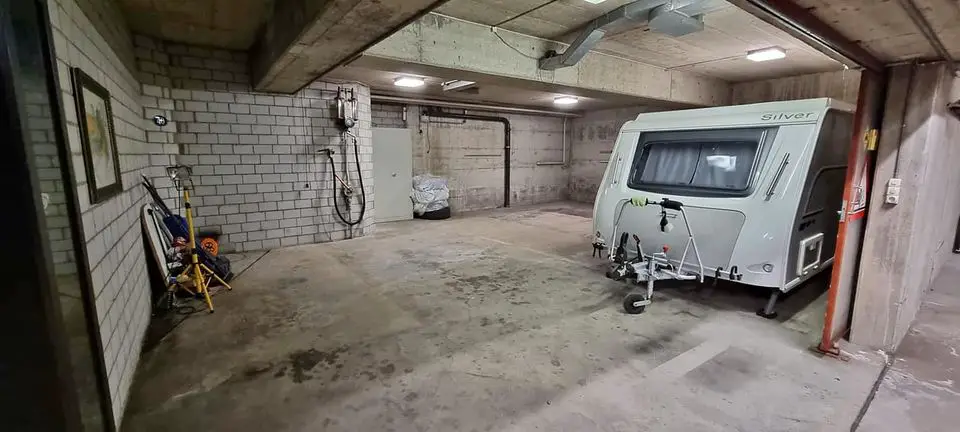Hi-van is supported by its audience. When you purchase using our links, we may earn an affiliate commission (no added cost to you). Learn more
When a storm hits and you can’t find shelter outside your van, you need to prepare for the worst. Fortunately for you, there are some methods to protect you from the weather inside of your van.

Here’s how you can prepare for and deal with storms during van life:
- Understanding Lightning and Its Power
- Determine what kind of storm is heading in your direction.
- Map out locations to park the van.
- Set up shelter.
- Prepare for the worst-case scenario.
While it may seem simple and easy to fight off storms while living in a van, it could be much more complicated than you think.
Read on to get special tips to deal with storms while living in your van.
1. Understanding Lightning and Its Power

Lightning is a powerful natural phenomenon that occurs during thunderstorms. It is a giant spark of electricity in the atmosphere, resulting from the buildup of electrical energy between clouds, air, and the ground. Thunderstorms form when warm, moist air rises, and cool air sinks, creating unstable weather patterns.
In a thunderstorm, you may witness different types of lightning, including cloud-to-ground, cloud-to-air, or cloud-to-cloud lightning. The most dangerous of these is cloud-to-ground lightning, as it can cause severe damage when it strikes the earth.
Understanding weather patterns is crucial for staying safe during a severe thunderstorm. Keep an eye out for thunderstorm watches and warnings issued by local weather stations.
Thunderstorm watch vs. thunderstorm warning
A thunderstorm watch means that conditions are favorable for the development of severe thunderstorms in the area, while a thunderstorm warning indicates that a severe storm has been detected and is imminent in the area.
2. Determine What Kind of Storm Is Heading in Your Direction
Knowing in advance what kind of storm is heading your way can give you a head start in preparing and assembling any equipment you may need. Even if there’s no storm that day, looking into future forecasts can help you prepare and plan.
Many people (myself included) underestimate when there’s only a light shower of rain or a tiny sprinkle of snow. You may think, “Oh, this isn’t bad. It may go away soon.”
Having this mentality, especially when you live in your van, can leave you less time to prepare or find shelter. Tuning in to weather forecasts will help prepare and give you general knowledge of what’s to come ahead.
Before heading out on your adventure, always check the weather forecast from reliable sources such as:
Being aware of potential storms or thunderstorms can help you make informed decisions about your route and campsite selection.
When choosing a campsite, it’s essential to keep lightning safety in mind. If you’re in a forest or wooded area, try to avoid camping near the tallest trees, as they can attract lightning strikes.
Instead, opt for a lower elevation area with smaller trees. In the wilderness, it’s best to avoid sheltering under an isolated tree, as it can be a prime target for lightning.
3. Map Out Locations To Park the Van
Before parking anywhere, you need to know what shelter conditions you’d need to deal with the storm.
Keep in mind that during a thunderstorm, your RV may not provide complete protection from lightning, so it’s essential to take extra precautions.
If possible, move away from trees and bodies of water, as they can increase the risk of a lightning strike.
Additionally, you should unplug your RV from the electrical outlet to prevent surges or spikes that can damage your electrical system.
In the event of a thunderstorm, remember that there is safety in numbers. If you’re traveling with a group, it’s best to stay together and avoid becoming the tallest object in the area. By keeping a low profile and choosing the safest location, you can reduce your vulnerability to lightning.
Staying informed, selecting a safe campsite, and taking necessary precautions can greatly reduce your risk during a lightning storm. With proper planning and attention to weather conditions, you can enjoy a safe and enjoyable RV adventure.
Two shelters that are best for van life during a storm and can battle extreme wind, snow, and thunderstorms are parking garages and open parking lots.
Parking Garages

One user from the subreddit r/vandwellers says, “Parking garages are a great shelter if you fit and worth the fee… I’ve been doing this for the major snowstorms all winter.” This means this van lifer has been doing this for a long time and has found parking garages are the best shelter for extreme snowstorms.
Parking inside a parking garage will also shield you from lightning during thunderstorms. As long as you aren’t in an area with overhead coverage, you’ll be fine.
Open Parking Lots

While this may not seem like the best idea, the same user from above also has said open parking lots are their go-to when a tropical storm hits their area. Why was this a good idea?
Parking your van in an open parking lot during extreme storms like tropical storms allows you to be far away from any flying debris.
Think about it; there’s nothing near you in an open parking lot. No trees, no lamp posts, nothing but possibly other cars. From a 1995 US study, “It would take perpendicular wind speeds of 101 mph to topple a 5m camper van.”
You wouldn’t have to worry about your van toppling over in a windstorm unless the wind speed is over 110 mph (162.54kph) or if your van is less than 5 m (16.4ft). If this storm includes thunder and lightning, flee the area.
4. Set Up Shelter
Sometimes you may not be near a parking garage or empty parking lot. In this instance, you’d have to set up your shelter to combat the weather.
If you’re experiencing a thunderstorm, the best way to take shelter is outside your van in an enclosed space. While you may think this is the opposite of the safest place, read below what the NWS has to say about lightning and vehicles.
According to the National Weather Service, “Although every lightning strike is different, damage to the antenna, electrical system, rear windshield, and tires is common. The heat from a lightning strike is sufficient to melt the antenna of a vehicle partially and can cause what seems like a small explosion of sparks as tiny fragments of metal melt and burn.”
If you’re unfortunate enough to be stuck in a snowstorm, the best thing for you to do is park and start a fire. Before you set anything up, you’ll need to clear an area for your gear and then set a fire.
Owning an awning will benefit you and your van immensely. Take a look at this video from Living The Van Life on YouTube:
The awning he has protects his fire and provides him extra space for his comfort.
In case of a thunderstorm or heavy winds, you should retract your awning and secure it properly.
5. Prepare for the Worst-Case Scenario
If you end up in a tornado warning, a blizzard with no end in sight, or even flash floods, the best thing is be prepared. If you can evacuate the area, then do so.
If you end up stuck for an unknown amount of time, stocking up on food and other items is necessary. You cannot live without food or water, so keeping an emergency supply is vital.
Down below are things to stock up on in case of an emergency:
- Non-perishable foods
- Canned goods
- Bottled water
- Blankets
- First-aid kit
- Propane canisters
- Batteries
- Radio
- Fire extinguisher
- Entertainment items
I recommend watching videos from Living the Van Life and reading for more tips on surviving storms while living in your van.
Final Thoughts
When it comes to safety during a lightning storm, being informed and prepared is crucial for RVers.
When camping in RV parks, choose locations that are relatively safe from lightning strikes.
Steer clear of tall trees, bodies of water, and other lightning-prone spots.
Here are a few essential tips for RVers to ensure safety during lightning storms:
- Move away from trees and water sources, as they can attract lightning.
- Unplug your RV from the electrical outlet to prevent power surges and damage to electronics. Running a built-in generator is a safer alternative.
- Have an emergency kit prepared, including a portable radio, flashlight, and a first aid kit.
- Retract your awning and secure it properly, and close all windows.
Following these safety tips and understanding the potential risks during a lightning storm will help make your RVing and camping experience enjoyable and secure.
Frequently Asked Questions
What precautions should be taken in an RV during a lightning storm?
During a lightning storm, it’s important to stay inside your RV and avoid touching any metal surfaces. Unplug electrical connections, including antenna cables and power cords, to minimize the risk of damage to your RV’s electronics. Close all windows and vents to prevent water damage from the rain.
How to ground an RV to reduce lightning damage?
To ground your RV, connect a braided copper wire to the metal frame of your vehicle. The other end of the wire should be attached to a metal grounding rod that is driven into the ground. It’s also a good idea to use a surge protector on your electrical connections to help protect your RV’s electronic systems from any electrical surges caused by lightning strikes.
Can lightning damage electronics in an RV?
Yes, lightning can damage electronics in an RV. If your RV is struck by lightning, the electrical surge can travel through wiring and damage electronic devices. Using surge protectors and unplugging electronics during a storm can help minimize the risk of damage.
Are specific types of RVs more resistant to lightning?
RVs with steel or aluminum frames are generally more resistant to lightning damage because their metal construction can act like a Faraday cage, preventing the electric charge from entering the interior of the RV.
However, no RV is completely immune to lightning damage, so it’s crucial to take necessary precautions during a storm.
What to do if an RV is struck by lightning?
If your RV is struck by lightning, first ensure that everyone inside is safe and not injured. Check for any visible damage, such as burn marks or melted wiring. After the storm, have an RV technician check the electrical systems and appliances to identify any internal damage that might not be immediately apparent. Also, consult with your insurance company to assess the scope of damage and file a claim if needed.
How to safely camp in an RV during bad weather?
It’s essential to stay informed about weather conditions when camping in your RV. Sign up for weather alerts, and be prepared to change your travel plans if necessary. When choosing a campsite, avoid low-lying areas prone to flooding, and park your RV away from tall trees that could be vulnerable to strong winds or lightning strikes. During storms, stay inside your RV and follow the precautions mentioned earlier in this section.
Find this content useful 🙂 ?
Subscribe to our Newsletter and get a free Solar Electric Diagram + shopping list.

